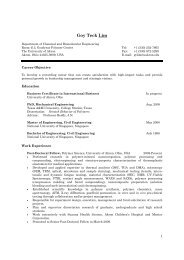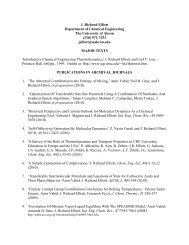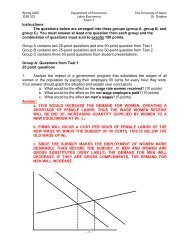Sociology of the Anarchists - Gozips.uakron.edu - The University of ...
Sociology of the Anarchists - Gozips.uakron.edu - The University of ...
Sociology of the Anarchists - Gozips.uakron.edu - The University of ...
Create successful ePaper yourself
Turn your PDF publications into a flip-book with our unique Google optimized e-Paper software.
auspice <strong>of</strong> <strong>the</strong> United States government). However, <strong>the</strong> “Federal government” has<br />
become a power unto itself, and autonomy <strong>of</strong> individual states can be over-ridden by<br />
hierarchical decisions nationally. [insert Watt's (2001) description <strong>of</strong> governmental<br />
federations here—try to adapt it to non-governmental forms] It is interesting to note<br />
that most anarchists (or, to my knowledge, social movement sociologists) have not<br />
explored this misuse <strong>of</strong> <strong>the</strong> words “federation”/”federal” and how <strong>the</strong> Articles <strong>of</strong><br />
Confederation set-up a relatively anarchist political order (in structure, not necessarily in<br />
policy, internal composition, or morality), which was ruined/gutted by <strong>the</strong> centralization<br />
<strong>of</strong> power by <strong>the</strong> subsequent Constitution. <strong>The</strong> anarcho-syndicalist Paul Goodman seems<br />
virtually alone in pointing out this fact. Weltman (2000) cites Goodman's argument that<br />
“<strong>the</strong> American colonies originated as anarcho-syndicalist communities” and that “<strong>the</strong><br />
colonies used government to limit <strong>the</strong> power <strong>of</strong> <strong>the</strong> individual and used participatory<br />
town meetings to limit <strong>the</strong> power <strong>of</strong> <strong>the</strong> government” (p. ??) [Also check Deleon 1973]<br />
Black blocs are usually considered to be a tactic, not an organization. But, some<br />
sociologist might still consider it to be an organization, just not a permanent-standing one<br />
–it is similar to <strong>the</strong> popular fad <strong>of</strong> a “flash mob”. Thus, <strong>the</strong>re is no “black bloc” to join or<br />
be a part <strong>of</strong>. Nor does any one person speak for <strong>the</strong> bloc. It just exists as a street<br />
demonstration phenomenon. Various local organizations will <strong>of</strong>ten make “a call” for a<br />
black bloc when a demonstration is happening in <strong>the</strong>ir community, intending that an<br />
internal unit <strong>of</strong> a march be composed <strong>of</strong> anarchists or anti-authoritarian activists. Black<br />
blocs are usually employed for some <strong>of</strong> <strong>the</strong> following reasons: to radicalize a liberal<br />
march, allow for internal anonymity in order to deter police provocation or “picking-<strong>of</strong>f”,<br />
to discourage internal authority figures and manipulation, and so forth. <strong>The</strong>re are also<br />
downsides to <strong>the</strong> tactic: unaccountability <strong>of</strong> “manarchists” 63 , marginalization by o<strong>the</strong>r<br />
activists and <strong>the</strong> press, and escalated danger from police engagement. 64 Indeed, anarchists<br />
are not above self-criticism: Severino (2003) asserts “We are indeed opposed to <strong>the</strong><br />
fetishization <strong>of</strong> <strong>the</strong> black bloc, which leads, among o<strong>the</strong>r things, to <strong>the</strong> phenomenon <strong>of</strong><br />
black bloc spectators as well as 'black bloc as fashion'” (Severino 2003, PAGE?). Even<br />
though <strong>the</strong>re is no “leadership” with a black bloc, it is usually understood that affinity<br />
groups are <strong>the</strong> organizational actors within, as affinity groups have discussed amongst<br />
<strong>the</strong>mselves <strong>the</strong>ir general strategies and tactics prior to joining <strong>the</strong> bloc. During <strong>the</strong> bloc,<br />
communication occurs with o<strong>the</strong>rs, but key decisions are made frequently amongst<br />
affinity group members.<br />
<strong>Anarchists</strong> have also responded in recent years to protest situations by <strong>the</strong> formation <strong>of</strong><br />
autonomous collectives <strong>of</strong> protest-oriented organizations, such as medics, legal observers,<br />
“radical cheerleaders”, who serve a specific purpose at an action (first aid, documentation<br />
<strong>of</strong> police abuses, and encouragement respectively). Such groups are spurred by <strong>the</strong> values<br />
<strong>of</strong> mutual aid and by <strong>the</strong> desire to assist in <strong>the</strong>ir own, unique ways to an action. This<br />
diffusion has benefited by <strong>the</strong> exchange <strong>of</strong> tactics and skills via <strong>the</strong> Internet, and by<br />
roaming “trainers” who help local groups form.<br />
Collective action <strong>the</strong>ory suggests that <strong>the</strong> divisions between ga<strong>the</strong>rings, demonstrations,<br />
and riots are easily blurred and can quickly transition from one category to ano<strong>the</strong>r.<br />
63 For more on <strong>the</strong> “manarchists”, please see <strong>the</strong> Rock Bloc Collective 2001.<br />
64 For more on black bloc tactics and assumptions about <strong>the</strong>m, please see <strong>the</strong> section entitled “Violence”.<br />
[ Williams 67 ] [ this is a draft. do not cite. ]






